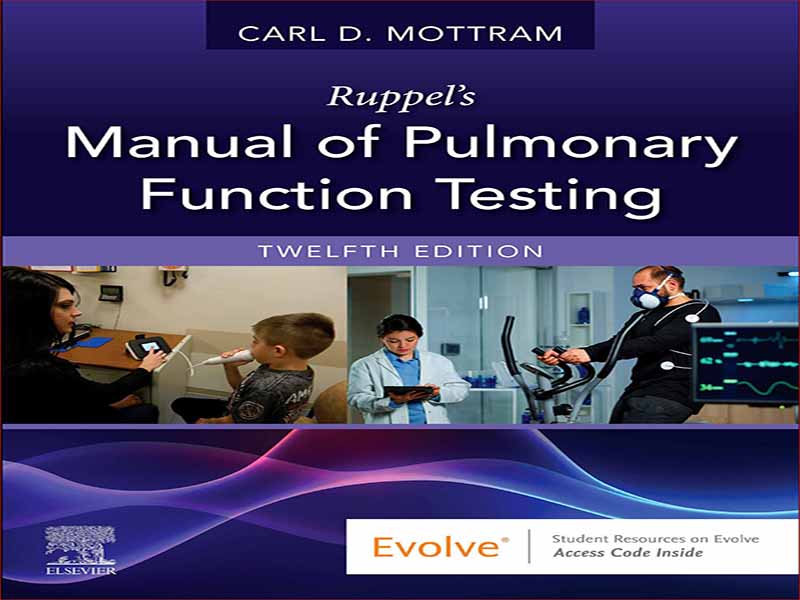- عنوان کتاب: Manual of Pulmonary Function Testing
- نویسنده: Carl D. Mottram
- حوزه: بیماریهای تنفسی, ریه
- سال انتشار: 2023
- تعداد صفحه: 531
- زبان اصلی: انگلیسی
- نوع فایل: pdf
- حجم فایل: 41.0 مگابایت
وظایف اصلی ریه اکسیژن رسانی خون وریدی مخلوط و حذف دی اکسید کربن است. تبادل گاز به یکپارچگی کل سیستم قلبی ریوی از جمله راه های هوایی، رگ های خونی ریوی، آلوئول ها، عضلات تنفسی و مکانیسم های کنترل تنفسی بستگی دارد. چند آزمایش عملکرد ریوی بخشهای جداگانه سیستم قلبی ریوی را ارزیابی میکند. با این حال، اکثر تست های عملکرد ریه وضعیت اجزای ریه را به روشی همپوشانی اندازه گیری می کنند. این ویرایش دوازدهم رایجترین تستهای عملکرد ریوی، تکنیکهای آنها و پاتوفیزیولوژی را که ممکن است توسط هر تست ارزیابی شود، توصیف میکند. موضوعات تحت پوشش شامل موارد زیر است: • تست های اساسی عملکرد ریه، از جمله اسپیرومتری، اندازه گیری حجم ریه (به عنوان مثال، پلتیسموگرافی بدن، شستشوی نیتروژن، و رقیق سازی هلیوم)، ظرفیت انتشار، و تجزیه و تحلیل گاز خون • کنترل تهویه و تهویه، تست های ورزش قلبی ریوی، و تست عملکرد ریوی کودکان و نوزادان • رژیمهای آزمایش تخصصی که بر اندازهگیری اکسید نیتریک بازدمی، تکنیکهای نوسان اجباری، مطالعات متابولیک، تعیین ناتوانی و ارزیابی قبل از عمل تمرکز دارند • تستهای چالش برونش که به پزشک در مشخص کردن بیشفعالیت راههای هوایی کمک میکند • عملکرد ریوی تجهیزات تست، تضمین کیفیت، و مقادیر مرجع و تفسیر. ویرایش دوازدهم شامل بسیاری از ویژگیهای نسخههای قبلی است: • اهداف آموزشی برای پزشکان سطح ابتدایی و پیشرفته دوباره در ابتدای هر فصل گنجانده شده است. • هر بخش آزمون شامل معیارهایی برای پذیرش و تکرارپذیری و همچنین راهبردهای تفسیری با معیارهایی است که برای کمک به افرادی که تست های عملکرد ریوی را انجام می دهند در رعایت استانداردهای شناخته شده سازماندهی شده اند. • اکثر معیارهای آزمایش بر اساس بیانیه های انجمن قفسه سینه آمریکا و انجمن تنفسی اروپا (ATS-ERS) هستند، و تعدادی از آنها بر اساس دستورالعمل های عمل بالینی انجمن آمریکایی مراقبت های تنفسی هستند. • راهبردهای تفسیری به صورت مجموعه ای از سؤالات ارائه شده است که می تواند به عنوان نقطه شروع برای تفسیر آزمون مورد استفاده قرار گیرد. در این نسخه، ما یک فرآیند فلوچارت را برای تفسیر سیستماتیک تستهای اساسی عملکرد ریه درج میکنیم. • مطالعات موردی با سناریوهای واقعی بیمار، سوالات و موضوعات بحث در پایان فصل گنجانده شده است. • نحوه پر کردن کادرها در بخش های آزمایشی خاص. اینها راهنمای گام به گام برای انجام تست های عملکرد هستند. در صورت امکان، ما تصاویر را ارائه می دهیم. این روش ها حدس و گمان را از انجام یک آزمایش دقیق خارج می کند. • Evolve Learning Resources دارای قابلیت Case Studies به روز شده در قالب پاورپوینت است تا مدرسان بتوانند از آنها در طول بحث های کلاس استفاده کنند. اسلایدهای سناریوی بالینی، سازماندهی شده بر اساس فرآیند بیماری، تجزیه و تحلیل عمیق موردی را با ارقام و نمودارهایی ارائه میدهند که ارزشهای آزمایشگاهی و گزینههای درمانی را ذکر میکنند. مربیان و گروه های مطالعاتی دانشجویی می توانند از آنها برای تکمیل تجربیات بالینی خود استفاده کنند.
The primary functions of the lung are oxygenation of mixed venous blood and removal of carbon dioxide. Gas exchange depends on the integrity of the entire cardiopulmonary system, including airways, pulmonary blood vessels, alveoli, respiratory muscles, and respiratory control mechanisms. A few pulmonary function tests assess individual parts of the cardiopulmonary system. However, most lung function tests measure the status of the lungs’ components in an overlapping way. This twelfth edition describes the most common pulmonary function tests, their techniques, and the pathophysiology that may be evaluated by each test. Topics covered include the following: • Basic tests of lung function, including spirometry, lung volume measurements (i.e., body plethysmography, nitrogen washout, and helium dilution), diffusing capacity, and blood gas analysis • Ventilation and ventilatory control, cardiopulmonary exercise tests, and pediatric and infant pulmonary function testing • Specialized test regimens that focus on exhaled nitric oxide measurements, forced oscillation techniques, metabolic studies, disability determination, and preoperative evaluation • Bronchial challenge tests that assist the clinician in characterizing the hyperreactivity of the airways • Pulmonary function testing equipment, quality assurance, and reference values and interpretation. The twelfth edition includes many of the features from the previous editions: • Learning objectives for entry-level and advanced practitioners are again included at the beginning of each chapter. • Each test section includes criteria for acceptability and repeatability, as well as interpretive strategies with criteria that are organized to help those who perform pulmonary function tests adhere to recognized standards. • Most of the testing criteria are based on the American Thoracic Society and European Respiratory Society (ATS-ERS) statements, with a few based on the clinical practice guidelines of the American Association for Respiratory Care. • The interpretive strategies are presented as a series of questions that can be used as a starting point for test interpretation. In this edition, we include a flowchart process for systematically interpreting the basic lung function tests. • Case Studies with real-life patient scenarios, questions, and discussion topics are included at the end of the chapters. • How To boxes populate specific testing chapters. These are step-by-step guides for performing function tests. When possible, we provide illustrations. These procedures take the guesswork out of performing an accurate test. • The Evolve Learning Resources feature updated Case Studies in PowerPoint format so that instructors can utilize them during class discussions. Clinical Scenario slides, organized by disease process, provide an in-depth case analysis, with figures and charts noting lab values and treatment options. Instructors and student study groups can use these to supplement their own clinical experiences.
این کتاب را میتوانید بصورت رایگان از لینک زیر دانلود نمایید.
Download: Manual of Pulmonary Function Testing




































نظرات کاربران